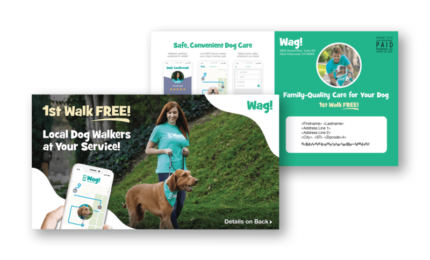Direct Mail Marketing Trends for 2025
By Paul Bobnak | November 14, 2024

Direct mail is a very effective marketing and branding channel because of how it differs from online messages. In many ways, mail has an opportunity like never before to stand out from the glut of digital marketing that surrounds us.
Improvements in technologies that make mail more special and relevant, changes in the digital ad marketplace, and incentives for mail plus the optimization of the USPS delivery network give marketers options to meet the right customers in their mailbox (and inbox) at the right time with the right message like never before.
These 4 trends provide ways to plan carefully and market more smartly in 2025.
1. Refresh Your Data & Design
Optimizing your mail spend is no longer just a nice thing to do – it’s a necessity. Investing in solutions saves you money in both the long and short run of your direct mail campaigns.
What’s needed is a reset of your mail campaigns to provide predictable and reliable control of your processes and costs.
To succeed in saving money and achieve more efficiencies:
Manage Your Data
Don’t let your data manage you.
Use tools to:
Dedupe your list data, break down silos, and run it through CASS (Coding Accuracy Support System) and NCOA (National Change of Address) before presort
Segment and target your audience using AI-driven testing and modeling strategies that analyze and target high-value cohorts
Analyze audience data and predict which segments are most likely to respond to specific messages
Personalize messaging, headlines, and images with variable data printing (VDP)
Rethink Mail Piece Design
The direct mail format that you’ve been mailing for years may no longer be as effective or affordable as it once was. You have many affordable options for design, printing, processing, and postage but also a wide range of costs associated with re-working the size of your current direct mail pieces and components, or switching to a smaller format.
Some possibilities include:
Reduce your catalog trim size from full-size to slim-jim with an equal or even higher page count
Replace an envelope package or flat with a folded self-mailer
Redo folded self-mailer campaigns with jumbo postcards
The savings resulting from reduced paper and postage costs may increase the ROI on your campaign.
2. Fine Tune Automation & Response Tracking
Shifting from resource-heavy manual processes to digital tools saves you time and money. Essentially, you’re running direct mail campaigns like you run digital campaigns – at the push of a button.
Automate Your Campaigns, Where Possible
Automation improves on the usual manual process to send direct mail campaigns. You simply make any changes to an existing template or upload a new mailer to a completely automated CRM system, just as you would with an email marketing campaign.
However, automation is “always on” at a more advanced level. It operates across channels by sending direct mail based on event- or behavior-based triggers. Data flows from point-of-capture (e.g., website visits, abandoned carts) into your CRM or CDP for printing and entry into the USPS mailstream.
Track Your Mail & Response
Full-service mailers using USPS Seamless Acceptance can offer significant postage discounts to customers. They use electronic documentation and Intelligent Mail barcodes (IMb) to automate and streamline mail entry verification.
Also, your mail campaign can save you even more money and time when drop-shipped to a USPS facility closer to your delivery points. Enrollment in Informed Visibility provides numerous benefits for tracking your mail and saving on postage, such as notification of delivery dates and better workflow planning.
3. Utilize USPS Incentives
Managing campaign costs is a perennial direct mail marketing trend. The biggest component, postage, continued the pattern of the last few years with two increases 6 months apart. The July 2024 postage hike averaged 7.8%, tied for the highest-ever. Along with service issues, the increases have prompted some members of Congress to propose reforms that would make USPS more accountable to regulators.
However, the USPS recently announced that rates will NOT increase in January 2025. This breather gives us a chance to focus harder on ways to save on mail spend without big decreases in mail volume.
Two programs will continue to provide the means for brands and marketers to save money on their direct mail in 2025.
Technology Incentives
For years, the USPS has been offering mailers incentives for mail campaigns that incorporate new and developing marketing and printing technologies. The idea is to “push the envelope”, to get marketers and printers to create high-value mail that drives engagement and increases ROI.
The 5 main promotions for 2025 are:
Integrated Technology (3% discount)
Tactile, Sensory and Interactive Engagement (4% discount)
Reply Mail IMbA (3% discount for static IMb, 6% for serialized)
Continuous Contact (3% discount
First Class Mail Advertising (3% discount)
Also, mail campaigns may qualify for 2 Add-On Promotions only when added to one of the 5 main promotions listed above. They are:
Informed Delivery (1% discount added)
Sustainability (1% discount added)
Mail Growth Incentive
The Mail Growth Incentives program covers both Marketing Mail and First Class campaigns mailed in CY 2024. The goal is to drive higher sustained usage of mail by large mailers, as well as encourage higher volume by the rest.
The incentive will rely on a FY 2024 volume to set a baseline for credits. Mailers who exceed 1 million in 2025, but did not mail 1 million in 2024, will have their incremental volume start at 1 million pieces, not their FY 2024 volume.
Mailers can earn 30% credit on the future volume of mailings (after July 2025) for overall volume exceeding 1 million pieces compared to their 2024 baseline.
The 30% credits will be paid out in three installments of 10% in July 2025, January 2026, and July 2026, and must be used by the end of 2026.
4. Increased Engagement
Call it digital fatigue if you’d like, but recent studies confirm direct mail’s power to engage an audience. Relevant data and tactile elements add value to a mail piece.
Here’s one example. According to the Vericast Direct Mail Influence Study:
Consumers spend 1.6 minutes on average with a direct mail ad compared to 1.1minutes for a digital ad
60% of respondents say direct mail ads are easy to remember when purchasing 44% for digital ads
The first fully-digital first audience of millennials said that direct mail is more personal than digital ads (54%), and that figure rose to 61% for millennial parents
Here’s another. As an experiment, Harvard Business Review mailed thousands of catalogs to customers of an e-commerce retailer. It discovered that those who received catalogs in addition to emails resulted in a 24% increase in purchases over those who only received emails. The catalogs created additional brand engagement and lifted sales across multiple channels. The study attributed this to designs using images and narrative or descriptive text in the physical catalogs.
Wrapping it up
Direct mail is a vital and evolving marketing channel. When it’s done well, it marries the power of personal touch and print to digital technologies. Mail helps brands to reach members of today’s audiences where each of them is and drives relevant and authentic interaction.
And we are committed to helping you achieve the best possible cost reductions and efficiencies for your direct mail campaigns in 2025. From planning to printing and mailing, we will work with you to reset your direct mail campaigns and save money every step of the way. Reach out to us to talk about it all!


